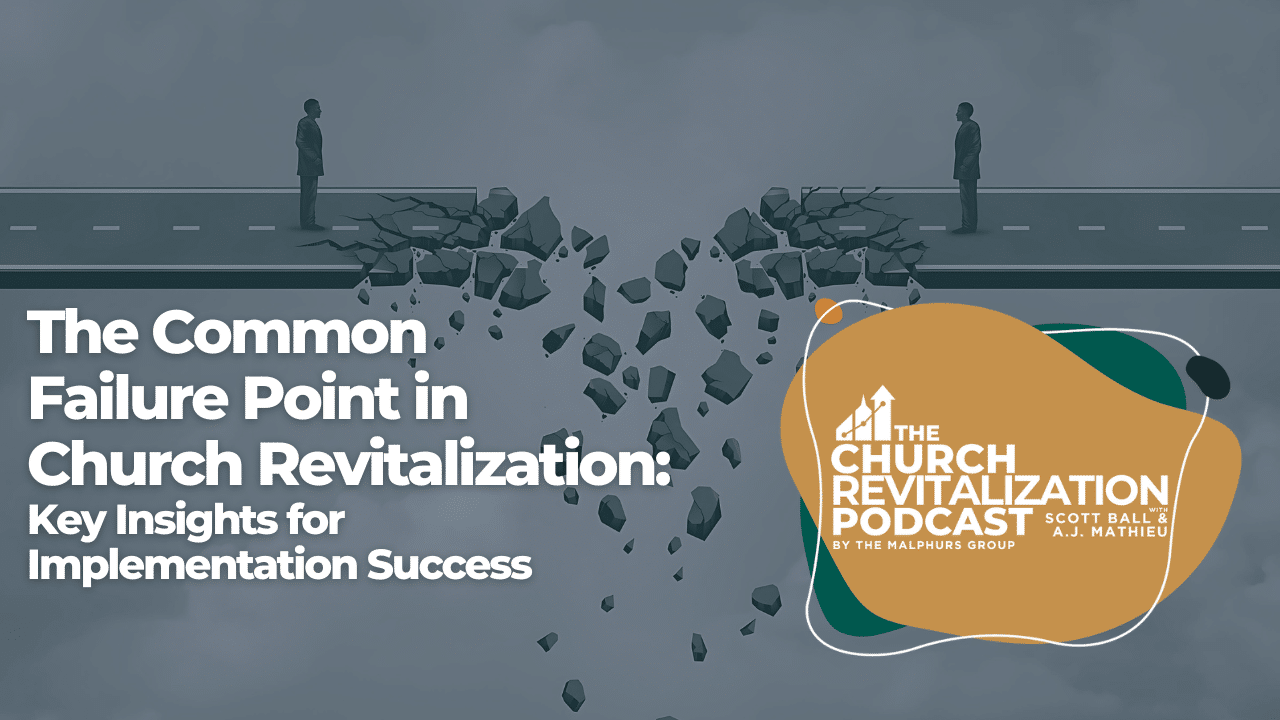The Church Revitalization Podcast – Episode 233
Although there are multiple points of church revitalization failure, the title is written in the singular because all the points below relate to one very important aspect of the revitalization process – implementation.
Churches usually take a long time to realize that they are in dangerous decline territory. Once that topic is broached and begins to be used in various conversations and meetings, eventually, it finds its way to a level of formalization amongst the leadership. At that point, it can go one of two ways. In some churches, it’s ignored, believing that things will just turn around at some point. In other churches, a decision is made to begin talking about what can be done. In those churches, some will decide that some kind of revitalization process should be pursued. The question may arise as to whether they should hire a consultant to help. Regardless of how that decision goes, outside help or internal process, the most common point of failure is the same.
I certainly will advocate for a consultant-led revitalization process. Yes, that’s our ministry, but the advantages of working with a consultant are many. If you’re thinking of hiring a consultant, be sure to read our “10 Things to look for in a consultant” article. Success can certainly be found in an internal process, but it will likely take longer, and there is a danger of not addressing the right things. Still, when all the planning is done, and it seems like everything has been covered, the hardest part remains – doing the work. No matter how hard the planning seemed to be, and it will be hard, it is only the beginning. Planning never changed anything. Change changes churches.
Subscribe below to never miss an episode.
Here are five things that can help make your revitalization work successful:
- Actually making plans to change
When all the planning is done, and it seems like everything has been covered, the hardest part remains – doing the work. No matter how hard the planning seemed to be, and it will be hard, it is only the beginning. Planning never changed anything. Change changes churches.
It’s been said that the definition of insanity is doing the same thing over and over and expecting different results. This is true in church revitalization. The status quo has resulted in today’s position. If you want tomorrow, next month, or next year to be different, you have to decide what you will do differently. There’s fun and easy change, and there’s difficult change, and we cannot decide what to change based on those options. The new guest welcome center in the lobby is fun and easy change. Reworking small groups to be consistent in function and retraining leaders is difficult change. Determining the best change for the church should be the priority, not the ease of implementation.
- Planning the change work
Didn’t we just cover this above? No. Deciding what to change is step one. Step two is planning the execution of those changes. For those of you who have led change in the business world, this would be known as project management. Some basic questions need to be answered:
- What is the end goal?
- What major milestones will mark progress?
- What steps are required to hit the first milestone?
- Who is responsible for accomplishing each step?
- What is the deliverable to show that the step is complete?
- What is the due date for completion of the step?
It takes engaged leadership to work through this process. We recommend that the pastor not be responsible for tasks in the implementation. Rather, the pastor may be the overseer or shepherd over the process. One of the benefits of working through revitalization is engaging other people in leadership. Adding to a pastor’s already full schedule of work is likely unsustainable.
- Continuing to meet
This one item will have the greatest impact on the revitalization process. And it is the easiest to do! Establish a regular rhythm of monthly meetings for the implementation teams, and stick to those meetings. You can expect that some people will not be able to make some of the meetings, but the alternative of trying each month to find workable days and times for everyone will likely prove futile in the end anyway and only add to the burden of the work. Set the dates, and encourage people to prioritize those meetings. When momentum and progress increase, those times together will become less burdensome.
- Surviving push-back
Implementation is hard. People who once supported the work may change their minds when it arrives at the doorstep of what they’ve become accustomed to. Most people value predictability and comfort, and change can be unsettling. There are two things that can help survivability through push-back:
First, do not assume that one or two people represent a majority. Though detractors tend to be vocal, they often don’t have much weight behind their cries for leaving the desert and returning to Egypt. Do the work to find out how widespread the issue really is. Don’t accept the classic “People are saying…” statements. Who is saying that? How many people are saying that?
Second, always lead through vision. Change is almost always more palatable when expressed with the reason it will result in a better tomorrow. Biblical support should always be incorporated, but don’t leave out the unique contextualization for your specific church and where you believe God is leading you together. It takes a clear picture of tomorrow for people to imagine it and see themselves in it.
- Having outside support
We’ve worked with many churches that previously attempted a self-directed revitalization process. Success can be found with the right leadership, but it will almost always come much slower. A Guide will help your church get to the most essential things more quickly and steer you away from known pitfalls along the way. As a pastor’s partner, they will be able to more freely say things that need to be said and reinforce ideas that have probably been preached for years by that time. To talk about how that may look for your church, go to https://malphursgroup.com/guide-directory/
There is too much at stake to start a revitalization process in the church, spend time in planning work and then not see it come together in positive change. A lot of relational capital can be expended that may take years to rebuild. Plan for success from the very beginning by seeing implementation through.


A.J. Mathieu is the President of the Malphurs Group. He is passionate about helping churches thrive and travels internationally to teach and train pastors to lead healthy disciple-making churches. A.J. lives in the Ft. Worth, Texas area, enjoys the outdoors, and loves spending time with his wife and two sons. Click here to email A.J.

